Environmental Impact Assessment
Legal Framework for the Planning and Construction of HOWaT
Currrently in the UK, the Crown Estate owns the majority of the seabed, within 12 nautical miles (Nm) of the shore. The Energy Act 2004 vested rights to The Crown Estate to license the generation of renewable energy on the continental shelf within the Renewable Energy Zone out to 200 Nm [1]. Therefore in order to deploy the HOWaT project on the chosen site, or any other around the UK under the 200Nm premises, a lease by such institutional body shall be granted. Such agreement for lease will grant an option over a specific area of seabed. Before being able to exercise the option, all statutory consents must be obtained through a series of obliged technical and environmental studies.
There is also need for offshore energy conversion technology to follow the guided legislation amogst the UK and European ambit.
Consents and Licenses Required
UK legislation
- Electricity Act 1989 – Section 36
- Food and Environmental Protection Act (FEPA) 1985 – Section 5
- Coastal Protection Act (CPA) 1949 – Section 34
- The Marine (Scotland) Act
European legislation
- Strategic Environmental Assessment Directive (SEA Directive)
- Environmental Impact Assessment Directive (EIA Directive)
- The Habitats Directive
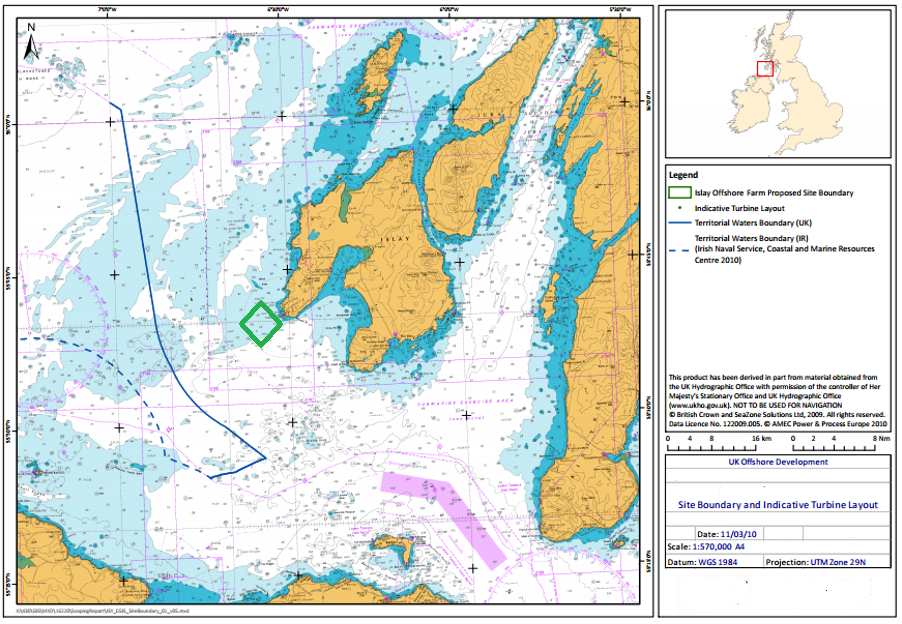
Assessment Methods and Approaches
The technology proposals (device type), physical environment, biological environment and consequences of human activities shall be assessed for the full life cycle of the wind-tidal farm including decommissioning. The following schematic shows all elements comprised in the proposed project.

A baseline risk assessment has been proposed for the marine and onshore phases of the project including the hybrid farm, subsea cabling and shoreline transition for offshore phase and buried cable from the shoreline and the sub-station/control building for onshore. The baseline risk assesment is a combination of impacts previously adressed in environmental scoping reports around the West of Islay by offshore wind [4] and tidal farms [5].

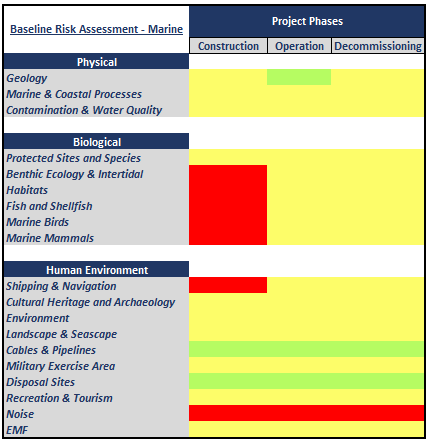
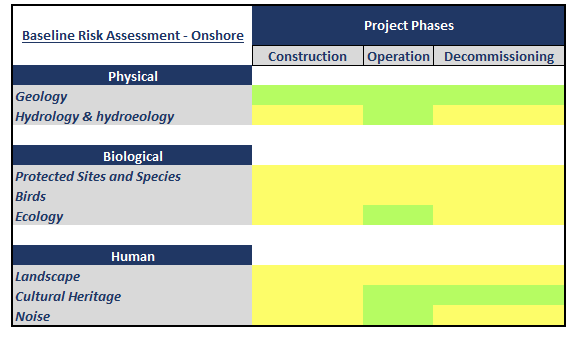
From the table it can be withdrawn that the biggest environmental impact, will be that caused in the marine environment. Regarding the human environment, noise is the main issue. The key sources of noise related to site preparation and device installation are broadly similar to those of decommissioning and those investigated for offshore wind farm construction; them being shipping, machinery, dredging and pile-driving or drilling. Since it’s an offshore development it is assumed that the noise impact will not affect human activities.
The increase impact of issues compared to a conventional offshore wind installation are further discussed in the Potential Impacts section.
Deployment Procedure
In order to minimise environmental impacts aswell as development and device risks it is proposed to develop the hybrid farm in three phases.
Phase 1
A small array of devices will be installed to demonstrate lead technology. The preliminary phase devices will be heavily instrumented and monitored as site specific demonstrations of technology. This shall provide both site-specific experience of the device performance, and of maintainability.
Phase 2
Addition of an excess of twenty devices, to test the viability of a greater infrastructure model based on grid connection and environmental impacts.
Phase 2
Construction of full farm.
Potential Impacts Summary
Carbon Dioxide Emission Reductions
Every unit (kWh) of electricity produced by wind and tidal displaces a unit of electricity which would otherwise have been produced by a power station burning fossil fuel. The use of HOWaT will result in a greater reduction of CO2, SO2 and NOx emissions in comparison to a conventional offshore wind turbine.
Emissions reductions (in tonnes) per year can be calculated using the following formulae [6]:
- CO2 = (A x 0.3 x 8760 x 860)/1000
- SO2 = (A x 0.3 x 8760 x 10)/1000
- NOx = (A x 0.3 x 8760 x 3)/1000
where A = the rated capacity of the wind energy development in MW, 0.3 is a constant, the capacity factor, which considers the intermittent nature of the energy sources, the availability of the turbines and array losses and 8760 is the number of hours in a year
This is a generally accepted fact used by many organisations including Government in their environmental calculations.

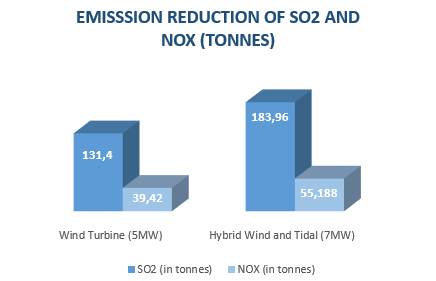
In the graphs it can be seen that the addition of two 1MW tidal turbines to a conventional 5MW wind turbine reduces by 4520,16 Tonnes more of CO2 per year than those reduced by a conventional 5MW wind turbine, also a reduction of 52,56 and 15,768 Tonnes of SO2 and NOx will be experienced. This reduction in emissions will be significantly beneficial to the environment and helpful in reaching reduction emissions imposed by international agreements (i.e. Paris Agreement, Kyoto Protocol)
Potential Impacts
A fictional scoping report has been assembled for the purpose of assessing all baseline risk factors and addressing their potential impacts, cumulative impacts and mitigation and monitoring measures. If interested, you will find it available below for download.
The following table is a compilation of the environmental affected issues which have increased in magnitude compared to an offshore wind device and summarises the impacts they may face upon interaction with HOWaT, the possibility of cummulative impacts and possible mitigation and monitoring measures that could be applied in order to minimise such impacts. [4] [5]
| Topics Addressed | Potential Impacts | Cumulative Impacts | Mitigation and Monitoring Measures | Reference Map (click to enlarge) |
|---|---|---|---|---|
| Benthic Ecology & Intertidal Habitats |
Direct and indirect disturbance due to the installation of turbine foundations, inter-array cables and from construction vessels (increase in suspended and deposited sediments) Increase in remobilisation of contaminants from seabed sediments and discharge of contaminants from construction vessels and presence of turbines leading to a reduction in water quality Underwater noise and vibration increase risk of physiological impact on benthic species |
Only short term impacts would be expected to be experienced and recolonization by the surrounding infauna is expected to take place rapidly. Due to the localised nature of impacts, cumulative and / or in-combination impacts are unlikely. |
Appropriate construction techniques could minimise increases in suspended sediments in the water column Scour could be mitigated, through the implementation of appropriate scour protection (rock armour, concrete mattressing or sediment stabilisation mats) |
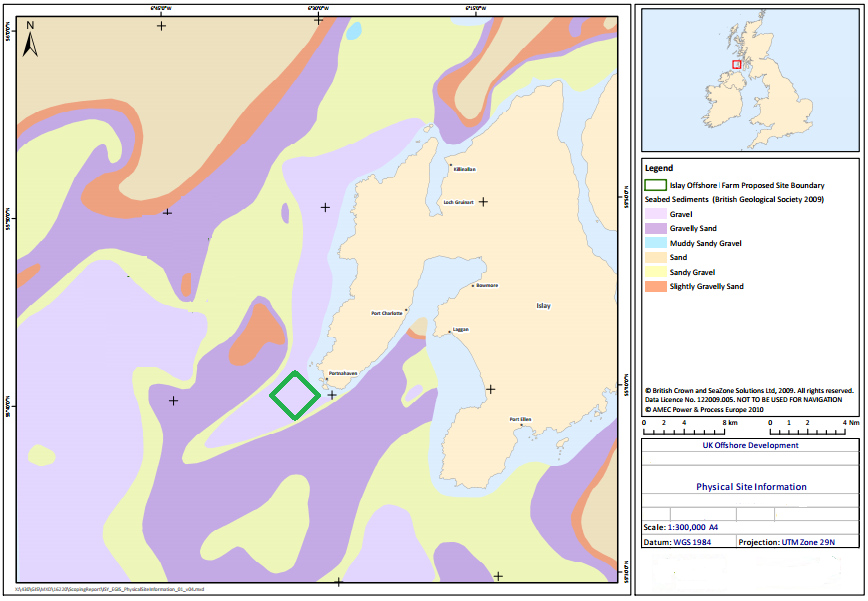
|
| Fish and Shellfish |
Direct disturbance and loss of spawning and nursery grounds Indirect impacts on spawning and nursery grounds, and on migration routes Disturbance to seabed habitats from increased sediment suspension and deposition Remobilisation of contaminants from seabed sediments and discharge of contaminants leading to a reduction in water quality Noise and vibration increase impact risk on noise sensitive fish and shellfish species. |
Impacts on noise sensitive fish species, e.g. herring, will need further assessment in terms of cumulative impacts. |
Use of low noise generating foundations and turbines. I.e. mitigation of piling noise such as‘soft-start’ (gradual increase in the force used to strike the pile) to piling operations. Contaminant management |
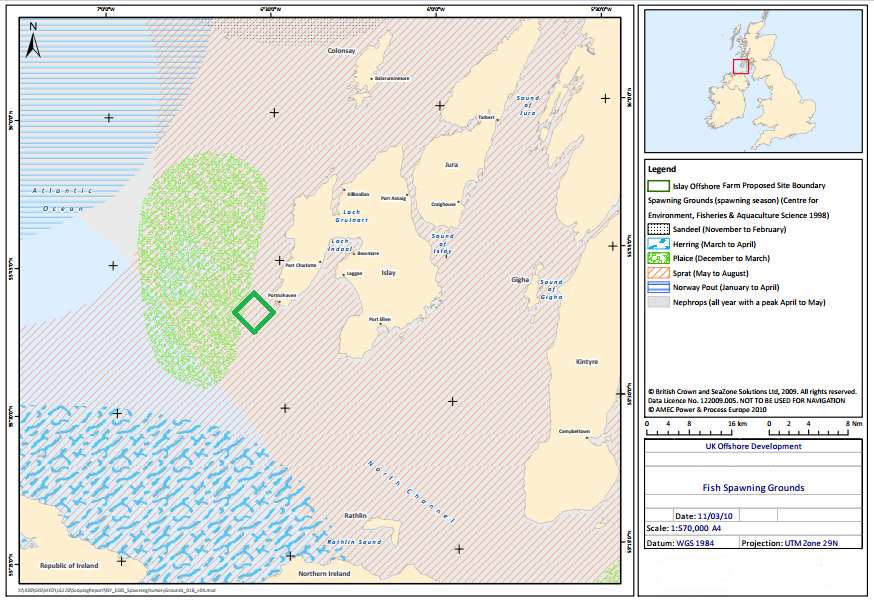
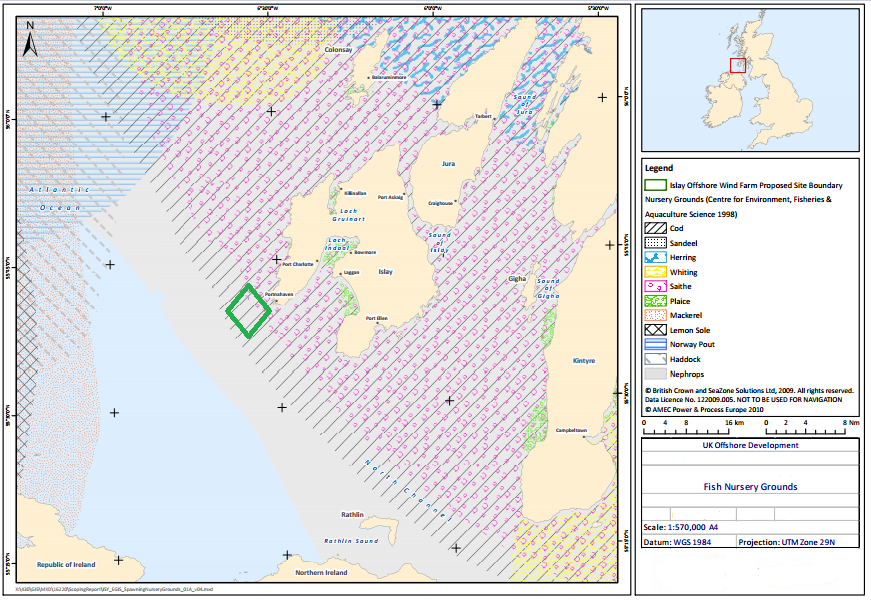
|
| Marine Birds |
Bird collision Risk of O&M Ships and bird collision Physical disturbance through noise and presence of turbine Increased turbidity (reduced visibility affects hunting) |
Ornithological impacts have the potential to act cumulatively with other projects, particularly with offshore and onshore wind farm sites within the area. Need of further study to assess cumulative impacts. |
Use of ‘considerate’ access routes to avoid flocks of rafting birds Use of ‘soft-start’ procedures to minimise initial piling noise Amendments to turbine layout to avoid areas of high bird activity |

|
| Marine Mammals |
Underwater noise and vibration inducing physiological/behavioural changes, i.e. displacement of prey species Masking of communication from noise with reproductive consequences Increased visual activity may disturb seals at haul out sites Pollution associated from the use of diesel, hydraulic fluids, and antifouling compounds Potential removal of habitat available for foraging / breeding |
Have the potential to act cumulatively with other sea regions. Need of further study to assess cumulative impacts. |
Marine Mammal Monitoring Protocol (MMMP) would also be designed with the aim of ensuring that no marine mammals are within a certain distance of the pile prior to or during pile driving activities. Use of acoustic deterrents, and other new measures available at the time of construction |

|
Expected Outcomes
Benthic Ecology
Impacts are expected to be of low magnitude and, therefore, the significance of all potential effects on benthic ecology are expected to be negligible.
Marine Mammals
As a result of the high conservation importance of marine mammals the significance of some impacts has been assessed as moderate, however, this represents a worst case and is a function of the high level of national and international protection afforded these species combined with a certain degree of uncertainty regarding the effects of an array of turbines on marine mammals.
Fish and Shellfish Resources
The construction methodology aims to minimise the significance of smothering effects on marine fish and shellfish. It is anticipated that the proposed development will have at worst minor effects on marine fish and shellfish resources with the main impacts being noise and vibration during construction and operation, along with the risks of turbines acting as a physical barrier to the movement of fish and those associated with potential collision.
Socio-economics, Tourism and Recreation
Is expected that the development of a HOWaT farm will bring minor beneficial socio-economic benefits to the area. Small number of local jobs may be created along with a temporary increase in spend on local services during the construction of the project. There will also be ongoing spend on local services associated with operation and maintenance.
Tourism and recreation are vitally important to the economy and community of Islay. Development of the array is not expected to have any significant long term adverse effect on existing marine and coastal activities, or on visitor numbers / visitor experiences. Any negative effects are expected to be short-term and experienced during the construction and decommissioning phases.The proposed development could have the possibility of becoming a new Islay tourism attraction, increasing the islands profile of pioneers renewable energy generation system.
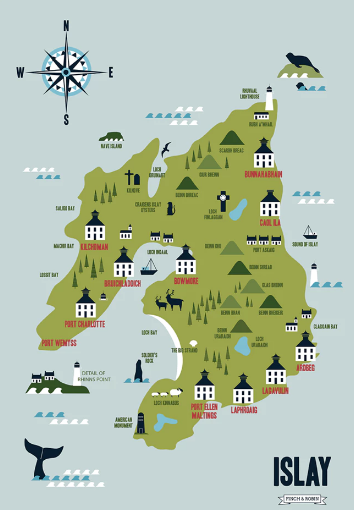
- The Crown Estate (2016).The Crown Estate’s role in the development of Offshore Renewable Energy
- The Crown Estate (2016).The Crown State Scotland Potfolio Update 2015/2016
- TenneT (2012). Grid Connection Regulations
- SSE Renewables (March 2010). Islay Offshore Wind FarmScoping Document
- DP Marine Energy (2009). Request for scoping opinion by DP MARINE ENERGY LIMITED in respect of Islay Tidal Energy Project - Environmental Impact Assessment Scoping Report
- British Wind Energy Association. Calculations for wind energy statistics Available online
- Finch and Robin Design Studio